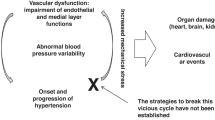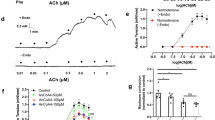Abstract
The vascular endothelium synthesizes and releases a spectrum of vasoactive substances like nitric oxide (NO) and endothelin (ET). In hypertension, the delicate balance of endothelium-derived factors is disturbed. ET acts as the natural counterpart to endothelium-derived NO, which exerts vasodilating, antithrombotic, and antiproliferative effects, and inhibits leukocyte-adhesion to the vascular wall. Besides its blood pressure rising effect also in man, ET induces vascular and myocardial hypertrophy, which are independent risk factors for cardiovascular morbidity and mortality. The derangement of endothelial function in hypertension is likely to be caused in part by genetic factors, but also due to elevated blood pressure itself. Due to its position between blood pressure and smooth muscle cells responsible for peripheral resistance, the endothelium is thought to be both target and mediator of arterial hypertension. Oxidative stress plays an important role in the pathogenesis of hypertension. Superoxide anions, ie, oxygen radicals produced in part by angiotensin II-activated NAD(P)H oxidase, can scavenge NO to form peroxy- nitrite, which can nitrosylate membrane proteins and oxidize lipids. Another source of superoxide is cyclooxygenase. Paradoxically, dysfunctional endothelial NO synthase may also be a source of superoxide anions. Surprisingly and in contrast to animal experiments, not all antihypertensive treatments consistently restore endothelium-dependent vasodilation in patients with arterial hypertension. Endothelial dysfunction in hypertension is crucial both for the development of the disease process in the vasculature and an important therapeutic target.
This is a preview of subscription content, access via your institution
Access options
Subscribe to this journal
Receive 12 digital issues and online access to articles
$119.00 per year
only $9.92 per issue
Buy this article
- Purchase on Springer Link
- Instant access to full article PDF
Prices may be subject to local taxes which are calculated during checkout
Similar content being viewed by others
Author information
Authors and Affiliations
Rights and permissions
About this article
Cite this article
Spieker, L., Noll, G., Ruschitzka, F. et al. Working under pressure: the vascular endothelium in arterial hypertension. J Hum Hypertens 14, 617–630 (2000). https://doi.org/10.1038/sj.jhh.1001012
Received:
Accepted:
Published:
Issue Date:
DOI: https://doi.org/10.1038/sj.jhh.1001012
Keywords
This article is cited by
-
Modeling early stage atherosclerosis in a primary human vascular microphysiological system
Nature Communications (2020)
-
Hydroxyhydroquinone Interferes With the Chlorogenic Acid-induced Restoration of Endothelial Function in Spontaneously Hypertensive Rats
American Journal of Hypertension (2008)
-
Isometric handgrip training improves local flow-mediated dilation in medicated hypertensives
European Journal of Applied Physiology (2007)
-
Isometric handgrip training improves local flow-mediated dilation in medicated hypertensives
European Journal of Applied Physiology (2006)
-
The role of angiotensin II in regulating vascular structural and functional changes in hypertension
Current Hypertension Reports (2003)



